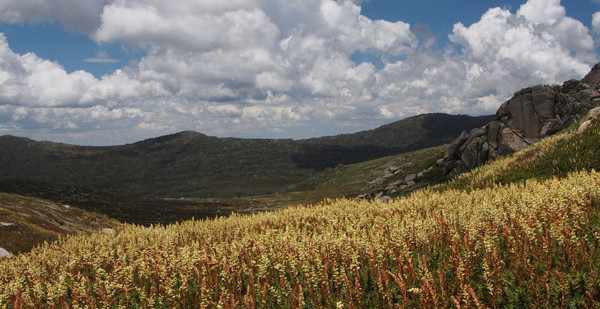The NSW National Parks and Wildlife Service (NPWS) has issued a statement to entice visitors to Kosciuszko National Park with the promise of stunning wildflower displays.
A press release offers ‘the best of summer wildflower blooms on display’, yet this exuberance for the park’s native blossoms hides a darker truth – here, like in so many other habitats, the effects of climate change and direct human impacts have already had severe effects.
NPWS alpine ecologist Ken Green has reported that 67 of the 200 native species are flowering, while ranger Danny Corcoran said that some species are flowering remarkably well.
“This year, the candle heath is the best I’ve ever seen it,” said Corcoran.
“Rainbow Lake and other short walks provide good ways to experience native Australian alpine wildflowers.”

Alpine everlasting (Xerochrysum subundulatum). Photo: Stuart Cohen.
Green notes that the time many of these plants flower has been impacted by earlier snow melts, while some species appear to be occurring at higher altitudes.
“Some species that we previously thought of as subalpine are certainly becoming more common in higher altitudes, which may well be a direct result of climate change,” Green said in a recent interview with Wild.
“However the most significant impact the changing climate as brought about is the fact that plants are flowering earlier in the season. 2014 saw the 11th earliest snowmelt on record and the general trend is that everything appears to be happening around two months earlier than they were a century ago.”
If that is the case, the wildflower blooms that can be witnessed today are likely to appear very different to those even a few decades ago, with invasive species also leaving their mark.
Kosciuszko National Park has always had its problems dealing with invasive species, with deer and horses in particular acting to spread seeds in their faeces.
“There are still only around 10 weed species present above the treeline,” said Green. “We try and spray these whenever they appear. Some have arrived during rehabilitation efforts following the decision to stop alpine grazing, while others continue to arrive on the wind, via pest animals and perhaps even with visitors.”
Botanist and Wild contributor, Dr Michele Kohout believes these weed species present a very clear threat to alpine environments as they do in many other habitats.
“These weeds tend to have a high competitive ability, meaning they can use more resources and reproduce faster than natives, which is why we must act quickly to control weeds wherever possible,” she said.
The most common of these weeds are grasses, dandelion, clover and milfoil, but Green reports that he has even begun to see examples of shrub willow and apple tree saplings.
“Apples are a great example of how bushwalkers need to take greater care,” Green said. “The only way they arrive is by discarded apple cores. Luckily these plants don’t tend to be very successful above the treeline.”
Woody plants such as apples and willows can be particularly damaging for native ecosystems, Kohout noted, highlighting the fact they can replace native plants and have greater influence over geological processes such as erosion and water system flow.
“Willows are often spread by suckers, but they do have the capacity to sprout from broken branches and therefore often spread downstream of the parent plant,” said Kohout. “They require large volumes of water and as a result their roots can work to slow water flow and reduce aeration. Willows have even been known to contribute to flooding and extreme erosion.”
Green also recommends bushwalkers avoid eating blackberries before they go hiking in national parks, as the seeds have been known to sprout in human faeces, while common velcro straps also have a high likelihood of collecting and distributing weeds, and especially grass, seeds.


